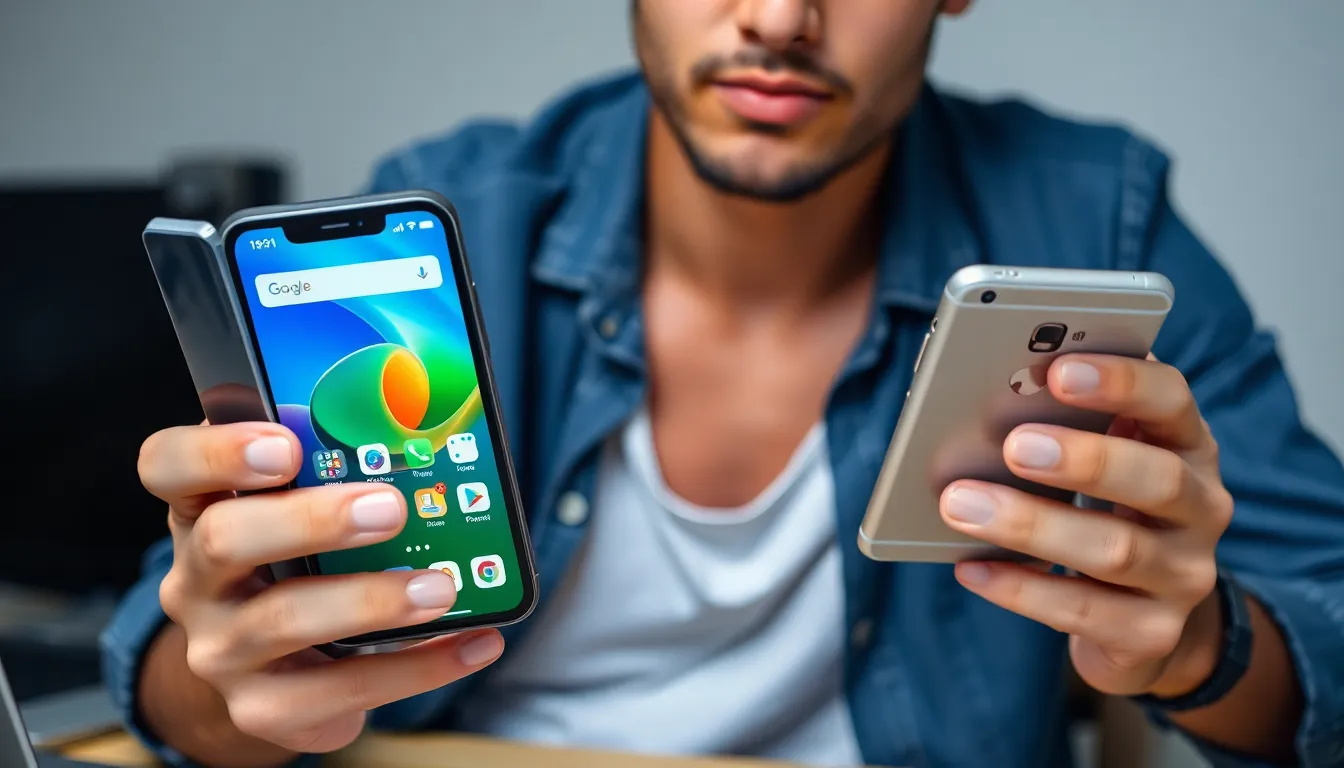Table of Contents
ToggleSwitching from Android to iPhone can feel like jumping from a cozy couch to a sleek sports car. It’s exciting but can also raise a few eyebrows—especially when it comes to transferring all your precious data. How long does this tech tango actually take? Spoiler alert: it’s not as long as waiting for your favorite show to buffer!
Overview of the Transfer Process
Transferring data from an Android device to an iPhone can be accomplished in several steps. First, users should download the “Move to iOS” app on their Android device. This app simplifies the transfer by allowing users to move contacts, messages, photos, videos, and web bookmarks directly to the iPhone.
Next, it’s essential to connect both devices to a stable Wi-Fi network. Once connected, users create a temporary connection between the Android and iPhone. This process ensures a secure transfer environment. The data transfer process usually takes around 30 minutes to an hour, depending on the volume of data involved. Keeping both devices charged during the transfer minimizes disruption.
During the setup phase on the iPhone, users will see an option to transfer data from an Android device. Selecting this option initiates the necessary steps. Users enter a unique code generated by the iPhone to establish a connection. This code is key for ensuring the transfer proceeds without issues.
Repeating the importance of a reliable Wi-Fi connection cannot be overstated. A stable connection ensures the process remains smooth, reducing the risk of data loss or interruptions. After the transfer, users may need to log in to their accounts on the new device, especially for apps that require authentication.
Familiarizing oneself with iOS features will help users adjust more quickly. Exploring the settings and applications on the new device enhances the transition experience, allowing users to enjoy their new iPhone immediately.
Factors Affecting Transfer Time

Several factors play a crucial role in determining the time required for transferring data from an Android device to an iPhone. Understanding these elements can help users prepare for a seamless transition.
Device Models and Compatibility
Device models significantly impact transfer speed. Older Android devices may operate slower than newer models. iPhones with updated iOS versions often support the latest features, improving compatibility. Limitations in hardware or software on either device could also lead to longer transfer times. For example, devices that lack recent software updates might experience delays. Ensuring both devices are compatible enhances the efficiency of the transfer process.
Data Volume and Type
The amount and type of data transferred affect overall transfer duration. Large volumes of photos, videos, or applications can extend the transfer time. Transferring essential data like contacts and messages typically takes less time than moving extensive media files. Users should prioritize what they transfer first. Essentially, a minimal amount of important data leads to quicker transfers. Meanwhile, higher quality media files require more bandwidth and time to complete the transfer.
Methods for Transferring Data
Transferring data from an Android device to an iPhone can be efficient and straightforward. Various methods exist to facilitate this process.
Using Move to iOS App
The Move to iOS app simplifies the transfer of data during the setup of a new iPhone. Users start by downloading the app from the Google Play Store on their Android device. A unique code generated on the iPhone connects the devices securely via Wi-Fi. Contacts, messages, photos, videos, and web bookmarks can transfer seamlessly. Completing this process typically takes 30 minutes to an hour, depending on the amount of data. Familiarity with the app enhances the transition experience, ensuring most essential information is prioritized.
Manual Transfer Options
Manual transfer options provide an alternative for those who prefer more control over the process. Cloud services like Google Drive or Dropbox enable saving files and data before transferring. Users can set up accounts on the iPhone after data upload. For contacts and calendar entries, syncing with Google accounts offers convenience. Transfer of specific apps or media content may require manual downloads from the App Store. Utilizing this method often takes longer but allows for selective transfer of relevant data, ensuring that only important information moves to the new device.
Tips for a Faster Transfer
Prioritizing essential data can significantly speed up the transfer process. Start by transferring contacts and messages, as these typically move quicker than larger files like photos or videos. Optimize the Wi-Fi connection by ensuring both devices are close to the router, which helps avoid disruptions during transfer.
Using the “Move to iOS” app makes the setup straightforward. Make sure the app is updated to the latest version. Choosing to transfer during off-peak hours can also enhance speed. Avoid connection issues by not using other bandwidth-heavy applications during the transfer.
Consider limiting the number of photos and videos to what’s necessary. Transferring a reduced amount of data can prevent a bottleneck, allowing for a faster overall execution. Backup options like Google Drive and Dropbox provide flexibility; uploading files first and then downloading them on the new iPhone ensures important data isn’t lost.
Logging into accounts immediately after the transfer expedites access to apps and data. Users should familiarize themselves with iOS features beforehand, which can help them navigate the new environment more quickly. Maintaining an awareness of the devices’ processing capabilities ensures a smoother transition, especially when model differences arise.
Switching from Android to iPhone can be a thrilling experience. While the process of transferring data might seem daunting at first, it’s generally quicker than anticipated. With the right tools and a stable Wi-Fi connection, users can complete the transfer in about 30 minutes to an hour.
By utilizing the “Move to iOS” app and prioritizing essential data, the transition can be smooth and efficient. Familiarizing oneself with iOS features ahead of time further enhances the overall experience. Embracing this change not only opens the door to new possibilities but also brings a fresh perspective on mobile technology.




